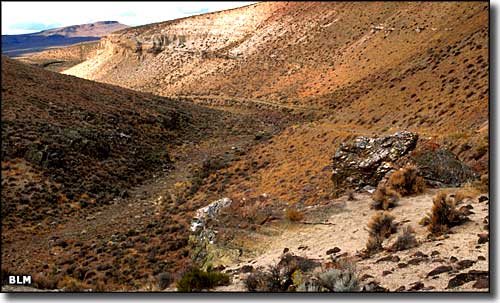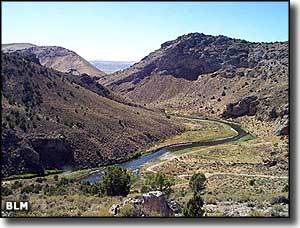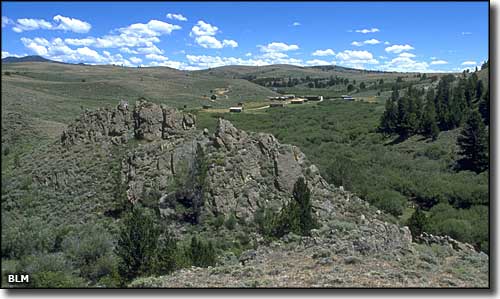 |
California National Historic Trail |
 Along the Lassen-Applegate Trail (a northern branch of the California Trail) in northwestern Nevada |
|
The California Trail has often been likened to a rope frayed at both ends. The eastern end of the Trail began in several places, mostly along the Missouri River. These eastern routes all came together near Fort Kearny on the Platte River in Nebraska and then led west to a place in Wyoming known as Parting of the Ways. From that point on, the rope became frayed again with many different cutoffs and variations being introduced the closer one got to California. The first recorded party to make the journey and reach California was the Bidwell-Bartleson party in 1841. They left Missouri with 69 people and reasonably easily reached Soda Springs, Idaho (following the Oregon Trail to that point). At that point, some of them elected to go on to Oregon over that established trail instead. The others headed southwest into the north end of the Great Salt Lake Desert and struggled mightily to reach their goal. They ended up abandoning their wagons even before they reached the Humboldt River in Nevada, having loaded every necessity they could onto their livestock. In November of that year, 39 of them reached California. |
 The California Trail wound along beside the Humboldt River in central Nevada The first group to reach California and take their wagons the whole distance was the Stephens-Townsend-Murphy party of 1844. They traveled the Truckee Route across the Sierra Nevadas and got caught by winter weather. They left some wagons at Donner Lake and made the rest of the journey on foot. The next spring they returned to Donner Lake and retrieved their wagons. John C. Fremont, guided by Kit Carson, explored a new route across the Great Basin in 1845. Late the next summer about 80 wagons of late-starting emigrants tried Fremont's new route. One of those late-starting parties was the ill-fated Donner-Reed party. That same year, another group from the Willamette Valley in Oregon opened a southerly route into Oregon that became known as the Applegate Trail. In 1848, an emigrant named Peter Lassen branched south off of the Applegate Trail to reach his northern California ranch. 1848 also saw the Mormon Battalion leave California, headed east for the Great Salt Lake area. They opened a wagon road south of Lake Tahoe over Carson Pass that later became the preferred wagon route to California during the big gold rush. James Marshall found that fateful gold nugget at John Sutter's sawmill, about 40 miles east of Sutter's Fort, on January 24, 1848. While gold-diggers flooded in from California, Oregon and Mexico through the rest of that year, news didn't reach the East Coast until that December when President James K. Polk confirmed the discovery to Congress. By the spring of 1849, gold fever was a massive disease infecting tens of thousands of Easterners. The sheer masses of people and livestock that then tried to make their way to California was akin to implementing a "scorched earth" policy against the Indian tribes whose countryside they crossed. Unsanitary conditions in the crowded campsites also contributed to the spread of cholera in areas that had never seen a white man (and never had the disease problem) before. Many new routes to California were opened, a lot of them fanning out from the Humboldt Sink in Nevada as travelers looked for easy ways to cross the Sierra Nevada Mountains. By 1860, the California Trail had become a huge road across the deserts of the Great Basin with branches leading off in many directions. |
 South Pass City, Wyoming: where most folks crossed over the Continental Divide |
|
In 1849, the vast majority of travelers on the California Trail were men. By 1852, about a third of those travelers were women and by 1857, it was common to come across wagon trains made up mostly of women and children. Another myth about the California Trail concerned the "savage, blood-thirsty" Indians. In reality, if it weren't for Indian assistance, many, many people would not have survived the journey. In 1844, Paiute Chief Truckee was guiding travelers along the river and through the pass in the Sierra Nevadas that was eventually named for him. But the tales of Indian depradations flew far and wide. In the 1850's and 1860's, the sheer number of emigrants aggravated the situation to the point that Indians and travelers were killing each other on a regular basis. However, many of these incidents were actually perpetrated by "white Indians:" common criminals dressed as Indians who followed after and preyed on the wagon trains, brutalizing, raping and murdering the travelers for their money and possessions. One traveler in 1850 remarked that the Indians were afraid to come near the wagon roads because of all the violence between the whites. Big travel on the long distance wagon roads finally came to a halt when the Transcontinental Railroad became a reality in 1869. The California National Historic Trail was designated by Congress in 1992. The Trail is administered by the National Park Service and managed in conjunction with the Bureau of Land Management, the National Forest Service, other federal agencies, state and local governments, and many, many private landowners whose properties are crossed by one section of the Trail or another. |
|
|

|
| Index - Arizona - Colorado - Idaho - Montana - Nevada - New Mexico - Utah - Wyoming National Forests - National Parks - Scenic Byways - Ski & Snowboard Areas - BLM Sites Wilderness Areas - National Wildlife Refuges - National Trails - Rural Life Advertise With Us - About This Site - Privacy Policy |
| Photos courtesy of the Bureau of Land Management. Maps of the California National Historic Trail are courtesy of the National Park Service and Bureau of Land Management. Text Copyright © by Sangres.com. All rights reserved. |